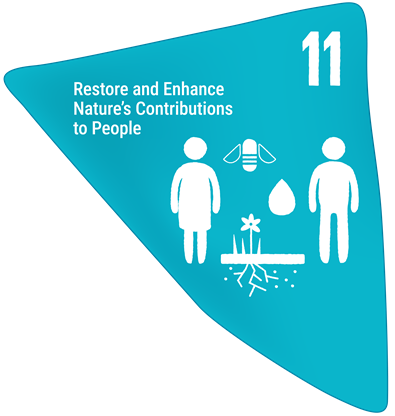
World Health Day -- 7 April 2024
Biodiversity encompasses all the complex interactions between living organisms that form the perfectly balanced ecosystems which support life: the air we breathe, the water we drink, the food we eat. There is no human health without biodiversity: it is integral to key development sectors that modulate health outcomes, such as pharmacy, biochemistry, agriculture, or tourism.
However, we are losing biodiversity faster than ever before. This loss threatens the multiple contributions of nature to our health. It increases the risk of disease, including pandemics, and our exposure air and water pollution and to extreme events.
Children, women, and the elderly are especially vulnerable.
Biodiversity loss also has severe adverse impacts on the health of indigenous peoples and their unique interdependent relationship with local ecosystems, impacting physical, mental, emotional, and spiritual health.
This year's theme: 'My health, my right'
To address these types of challenges, the theme for World Health Day 2024 is 'My health, my right’.
This year’s theme was chosen to champion the right of everyone, everywhere to have access to quality health services, education, and information, as well as safe drinking water, clean air, good nutrition, quality housing, decent working and environmental conditions, and freedom from discrimination.
As declared by the United Nations General Assembly in July of 2022, all people have the right to a clean, healthy and sustainable environment. The fulfilment of this right is necessary for the full enjoyment of a wide range of human rights, including the rights to health, food, and water. And it requires that we protect nature.
The Biodiversity Plan
Over the last decade, the many and complex linkages between biodiversity and human health have been increasingly recognized. The Kunming-Montreal Global Biodiversity Framework (the Biodiversity Plan) recognizes that the health of humans, animals and plants, wild and domestic, and the integrity of ecosystems are all linked and interdependent. Its four goals aim to protect and restore nature, to prosper with nature, to share benefits fairly, and to invest and collaborate for nature.
Achieving the goals and targets of the Plan is essential to realize our right to health. We must all be part of the Plan.
More information:
Related Targets in The Biodiversity Plan
Restore, maintain and enhance nature’s contributions to people, including ecosystem functions and services, such as regulation of air, water, and climate, soil health, pollination and reduction of disease risk, as well as protection from natural hazards and disasters, through nature-based solutions and/or ecosystem-based approaches for the benefit of all people and nature.
Why is this target important?
Nature’s contributions to people, a concept similar to and inclusive of ecosystem services, refers to all the contributions from biodiversity to people’s well-being or quality of life. These contributions take various forms, including material contributions, regulating services and other non-material contributions including spiritually and culturally. As a result of the ongoing decline of biodiversity, nature’s contributions to people are also in decline, with serious implications for human well-being and social cohesion. The restoration, maintenance and enhancement of nature’s contributions to people provides an important rational for the conservation and sustainable use of biodiversity.
Links to other elements of the Biodiversity Plan and other frameworks and processes.
- Actions to reach Target 11 should take into account all of the considerations for implementation identified in section C of the Kunming-Montreal Global Biodiversity Framework.
- Progress towards this target will support the attainment of goals A and B of the Kunming-Montreal Global Biodiversity Framework. Progress towards this target will be facilitated through the actions taken to reach the other targets of the Global Biodiversity Framework, in particular those targets addressing the direct drivers of biodiversity, namely targets help to reach targets 2, 3, 5, 6, 7, 8, 9, 10 and 12.
- Elements of Target 11 were previously addressed under Aichi Biodiversity Target 14.
- Elements of Target 11 are also addressed in the targets of the Sustainable Development Goals, including targets 1.5 and 15.4

Significantly increase the area and quality and connectivity of, access to, and benefits from green and blue spaces in urban and densely populated areas sustainably, by mainstreaming the conservation and sustainable use of biodiversity, and ensure biodiversity-inclusive urban planning, enhancing native biodiversity, ecological connectivity and integrity, and improving human health and well-being and connection to nature and contributing to inclusive and sustainable urbanization and the provision of ecosystem functions and services.
Why is this target important?
Green and blue spaces have a range of positive effects on human physical and mental well-being. Ensuring the availability and accessibility of such areas is particularly important given that the increasing trend towards urbanization risks separating people further from nature, with potential negative effects on human health and reduced understanding of biodiversity, and the ecosystem services it provides. Further, green and blue spaces can provide important habitat for species, improve habitat connectivity, provide ecosystem services and help mediate extreme events, if managed with such objectives in mind. The target focuses on the importance of biodiversity-inclusive urban planning and making space for nature within built landscapes to improve the health and quality of life for citizens and to reduce the environmental footprint of cities and infrastructure. It also recognizes the dependency of urban communities on well-functioning ecosystems and the importance of spatial planning to reduce the negative impacts on biodiversity of urban expansion, roads and other infrastructure.
Links to other elements of the Biodiversity Plan and other frameworks and processes.
- Actions to reach Target 12 should take into account all of the considerations for implementation identified in section C of the Kunming-Montreal Global Biodiversity Framework.
- This target will contribute to the attainment of goals A and B of the Kunming-Montreal Global Biodiversity Framework. Progress towards this target will also help to reach targets 2, 3, 4, 8 and 11. Conversely, progress towards this target will be support by actions to reach targets 1, 14, 19, 20, 21, 22 and 23.
- Elements of Target 12 are also addressed in the targets of the Sustainable Development Goals, including targets 11.7 and 11.b.
